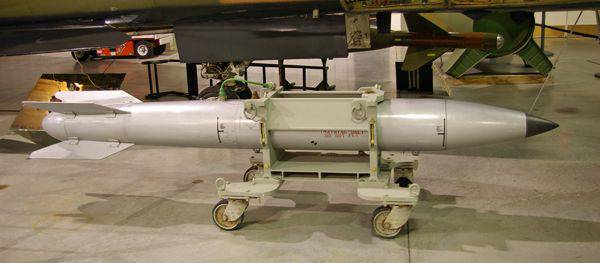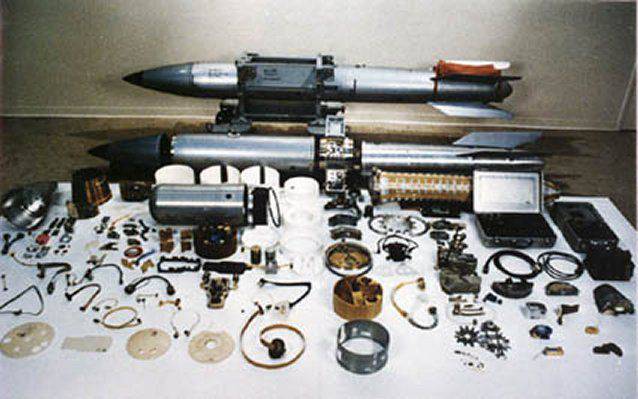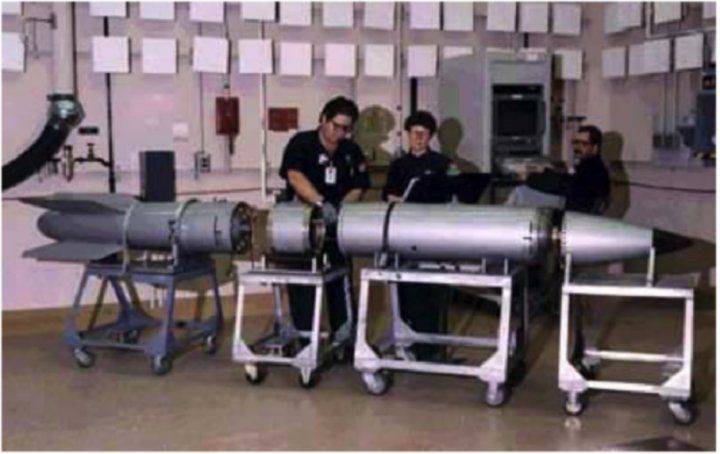Tactical thermonuclear bombs of the B61 family (USA)
History The B61 bomb began in 1960, when nuclear scientists at the Los Alamos and Sandia National Laboratories were given the task of working out the issue of creating a small-sized aviation bombs with a thermonuclear warhead. As part of the new FUFO project, it was planned to study existing and promising technologies, as well as determine the very possibility of creating the required weapons. If there was a fundamental possibility, specialists should start designing new weapons.

The preliminary study took about two years. Scientists from several research organizations have confirmed the possibility of creating a relatively light bomb with a full-fledged thermonuclear warhead and all related equipment. During the first few months, all work continued under the FUFO project. In January, 1963, the development received a new designation - XT-61. By this time, the basic requirements for new weapons were identified. A prospective bomb should have a weight of no more than 700-800 pounds and carry a thermonuclear charge of variable power. In addition, there were quite serious requirements for the use of such weapons. The military wanted a bomb suitable for dumping at different speeds and altitudes.
The simplest stage of the project was the development of the hull. Already 20 August 1963, began testing of buildings with ballast. The purpose of these tests was to determine the aerodynamic characteristics of the developed hull when dumping from different heights and at different speeds. By the time the field tests began, several of the proposed hull structures had passed a series of blowdowns in the wind tunnel, so the test faults were completed on the whole successfully.
The next two years were spent on improving various units and creating a full-fledged thermonuclear warhead. Work on the organization of mass production of new weapons started only in May 1965 of the year. The assembly of the first batch of new weapons also took a lot of time. The first XT-61 bomb was manufactured in October on the 66. By this time, promising products received a new designation used to this day - B61. At the very beginning of 1967, the first bombs of the new model were handed over to the troops. The new weapon was classified, because of what the Air Force personnel were forbidden to use its name in the negotiations. The military were forced to use euphemisms like "silver bullet", "external suspension", etc.
The new tactical thermonuclear bomb had a cylindrical body with a conical head fairing. The total length of the bomb of the first B61-0 modification was 3,6 m with a case diameter of 33 cm. The total weight of the product was 700 pounds (about 320 kg). Later, various projects for the modernization of the bomb were created, during which both the dimensions and the weight changed. Nevertheless, despite all the changes, similar parameters of the product remained approximately at the same level.

The hull lines were calculated taking into account the transport of a bomb on an external sling when flying at supersonic speeds. The carrier plane with the B61-0 bomb could fly at speeds up to M = 2. However, in some cases, it was necessary to slow down before dropping a bomb.
All bombs of the B61 family were divided into four main compartments. The head compartment contained several fuses. A radio-fuse was used for blasting at a given height, and piezoelectric systems for contact blasting. In the central compartment were placed all the units of the thermonuclear warhead. To ensure performance in various conditions, the central compartment was sealed and equipped with a durable outer casing. In the rear compartment of the corps was a set of equipment for the management and maintenance of the bomb. In particular, there were all the necessary connectors for connecting to the onboard systems of the aircraft carrier. To the body was attached tail unit. In its central part of the place was provided for braking parachute.
One of the main requirements for a promising tactical thermonuclear bomb was to ensure that it could be used with various aircraft carriers. Due to the use of standardized components and the simplest set of onboard equipment, it was possible to ensure the highest flexibility of use. As the B61 family of bombs and combat aircraft developed, the number of possible carrier types exceeded two dozen. Such weapons can be used both by tactical aircraft fighter-bombers and heavy bombers.
A set of fuses and a tail parachute also increased the flexibility of use. Depending on the mission and type of target, bombs of the B61 family can operate in several modes. Undermining the warhead can be done at a predetermined height, when touching the ground or with some delay after touching (up to 80 s). In order to avoid consequences for the aircraft carrier after dropping the bomb, a parachute was thrown and it was lowered to the target. During the tests, it was revealed that a strong Kevlar parachute with a diameter of 7,3 m at a discharge speed of about M = 1,2 is capable of slowing down a bomb to 50-55 km / h in just two seconds. The bomb was allowed to drop from heights from 15 m to the ceiling of the aircraft carrier.
Over time, it became possible to use B61 bombs as anti-bunker weapons. For this proposed bombs with a reinforced hull. When falling, the bomb should not have opened the parachute, maintaining the speed necessary for penetration into the ground. To explode, a piezoelectric fuse with a set delay was used.
Depending on various reset parameters, etc. the circular deviation of bombs of the B61 family, which were not equipped with any guidance systems, did not exceed 200 m. Given the power of the warhead, this accuracy was sufficient for most of the intended tasks.
The most important feature of the thermonuclear warheads of the B61 family of bombs was the ability to set the power of the explosion depending on the task. Uranium charge with an initiating charge of explosives was used as the first stage of warheads. As a second stage, the bomb carried a charge of lithium-6 deuteride. At the expense of some measures, bombs of the B61 family could be undermined with various capacities. The number of such settings and possible powers of detonation depended on the modification of bombs.
The basic version of the warhead capacity up to 170 CT was so successful that in the future it was used in the development of some other thermonuclear warheads used as part of other tactical and strategic weapons. In the early seventies, the W69 warhead was developed for the AGM-69 SRAM missiles. For AGM-53 Condor missiles, the W73 products were intended. A total of nine types of warheads were developed based on the B61 bomb warhead. Most of them have already been decommissioned and disposed of.
For more than half a century, more than ten modifications of the B61-0 base bomb have been developed. All these types of aircraft armament differed from each other by various design features and equipment. In this case, however, not all modifications have reached mass production. Modifications with the legend Mod. 6, Mod. 8 and Mod. 9 was developed, but did not reach production. Other versions of the thermonuclear bomb alternately replaced and complemented each other in the arsenals.
In its basic configuration, B61 bombs remained the main tactical thermonuclear weapons of the US Air Force until the early eighties. In 1980, the deliveries of serial products B61 Mod. 3 or B61-3. When upgrading, minor modifications were made to the design of a thermonuclear warhead. First of all, the initiating explosive was replaced, which led to the undermining of the charge of the first stage. The bomb control system for the first time in the family was built on the basis of microprocessors. The B61-3 bomb had four types of explosive power: 0,3 kt, 1,5 kt, 60 kt and 170 kt.
Simultaneously with the B61-3 product, the B61-4 bomb appeared. According to reports, these munitions were similar in design, but differed in combat units. Air Bomb Mod. 4 also had four power settings: 0,3 CT, 1,5 CT, 10 CT and 45 CT.
Soon the B61-7 modification appeared. The aim of this project was to update the existing bombs of the first models in order to improve their characteristics. The design of the thermonuclear charge and the electronics of the onboard systems control were seriously reworked. A characteristic feature of the bomb Mod. 7 is a relatively high power: from 10 to 340 CT. Thus, the bombs of this modification are the most powerful in the family.

As the MGM-31C Pershing II ballistic missiles were written off as part of the implementation of the medium-range and short-range missile treaty, the United States released W85-type thermonuclear warheads. It was decided to use these warheads as part of the next modification of the B61 bomb - Mod. 10. The operator had the opportunity to choose one of four capacities of the explosion: 0,3 CT, 1,5 CT, 10 CT and 80 CT.
In the mid-nineties, the latest at the moment serial modification of the bomb - B61-11. It is a modified version of the B61-7 with a reinforced body. New durable structural elements allow the bomb to sink into the ground before the explosion. This increases the impact of the bomb on the underground target - a bunker or other similar structure. According to different sources, the power of a charge of bombs B61 Mod. 7 and B61 Mod. 11 is the same - up to 340 CT. Depending on the parameters of the reset bomb Mod. 11 can punch up to 6 m of concrete or more 20 m of soil.
Since the mid-sixties, the US industry has released 3155 bombs B61 of various modifications. During operation, some of these products were upgraded over time, as a result of which the service life was extended and, to a certain extent, the characteristics were increased. However, thermonuclear weapons have a limited lifespan, with the result that most of the different types of B61 bombs were written off by the beginning of the two thousandths. According to some sources, by 2002, more than 1900 bombs were written off and disposed of. No less than 1200 while remaining in warehouses.
The existing bombs of the B61 family are still suitable for use, but they no longer fully meet the requirements of the time. For this reason, in 2010, the US Department of Energy, in charge of all nuclear and thermonuclear weapons projects, initiated the development of a new modification of tactical bombs. It was planned to spend about 2 billion dollars for design and the subsequent modernization. A new bomb should get the designation B61-12.
It was reported that a new model of the bomb should be based on the units of its predecessors. It was supposed to equip the Mod bomb. 12 new tail section. It was proposed to remove the parachute system that does not meet modern requirements. Instead of a parachute in the tail of the bomb should be located guidance systems. As part of the B61-12 product, a block of equipment similar to that used in the JDAM bomb will be used. Due to the satellite navigation system and the rudders, the updated bomb will be able to hit the target with increased accuracy.
It is expected that the new control systems will significantly improve the combat characteristics of the updated bombs. In particular, this will make it possible to abandon the use of high-power warheads. The new B61-12, according to some data, will hit the target with an explosion of 0,3 km, 1,5 kt, 10 kt or 50 kt.
The first tests of a modernized thermonuclear bomb were planned for 2015. Around the same time, preparations should begin for the modernization of the aircraft, which will become carriers of B61-12. Operation of the new weapon will begin no earlier than 2020 of the year. In the future, it is possible to integrate such bombs into the armament complex of promising LRS-B bombers. In addition, work is already underway to ensure the compatibility of the new bomb and the F-35 fighter-bomber.
Earlier, some details of the LEP / B61-12 project were reported, which may be the reason for disputes in the international arena. The fact is that the Pentagon and some NATO countries are planning to modernize their aircraft equipment in the foreseeable future. Among other things, upgraded aircraft should receive a set of equipment for the use of tactical thermonuclear bombs of the new model. Thus, the states that have acceded to the Treaty on the Non-Proliferation of Nuclear Weapons will be able to obtain aircraft capable of carrying such weapons. Such plans and actions need additional study and evaluation of the competent authorities.
As follows from the published information, all available tactical bombs of B61 of various models will be re-equipped in the foreseeable future according to a new project. Thus, the life of a fairly old bombs will be extended for another few years. By the end of this decade, it will be half a century since the start of operation of the B61 bombs. Before the advent of the LRS-B bombers, which are planned to be one of the main carriers of such weapons, it will take another 10-15 years. As a result, B61 tactical bombs can become one of the oldest types of weapons available to the United States. Whether the strategy of upgrading existing bombs justifies itself - time will tell.
On the materials of the sites:
http://globalsecurity.org/
http://nuclearweaponarchive.org/
http://fas.org/
http://nevskii-bastion.ru/
http://nti.org/
http://nukestrat.com/


Information